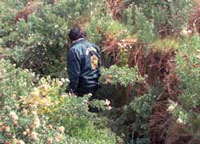¿Has NASA set its sights on the Chupacabras?
Date, Tuesday, June 12, 2001
Translation (C) 2001 S. Corrales, Institute of Hispanic Ufology.
Special thanks to Dr. Virgilio Sanchez Ocejo
¿Será posible que la Nasa recorra los rincones de la Provincia El Loa buscando evidencia extraterrestre y supuestos Chupacabras, tal como lo hizo la Policía de Investigaciones en Yalquincha el año pasado?.
The possibility that NASA is committing resources in the Province of El Loa to secure evidence of extraterrestrial life in order to obtain scientific knowledge applicable to a number of earth sciences, including technology, is rather acceptable and almos likely for Calama UFO Research center investigator Jaime Ferrer, who claims having in his possession information which leads to the belief that the organization operates in the area.
This fantastic theory, which seems drawn from the minds of Orson Welles and Steven Spielberg, is so firmly rooted in reality for the UFO investigator that he does not even dismiss the possibility that the National Aeronautics & Space Administration may be keenly interested in the capture of alleged Chupacabras specimens which roam the broad Chilean desert. These entities, according to Ferrer, possess an enormous amount of qualities worthy of imitating or extrapolating into human inventions. Personally, the ufologist from El Loa believes that the so-called Chupacabras is a biological entity of unknown origin for the modern world rather than a genetic experiment performed by NASA, since his studies, as he remarks, managed to ascertain the creature's existence during remote times and places. "Of course NASA is interested in it, because it does not posess natural qualities. The agency has the necessary powers available for managing this type of operations," he explained.

STRANGE BUT TRUE
According to Ferrer, people tend to believe that NASA is incapable of venturing into fields of research that may seem hairbrained or laughable, however, this behavior is more customary that one would think among scientists belonging to the U.S. space agency, who face complex cosmic challenges day after day, and whose solution must be found while its astronauts are still firmly planted on Earth
A clear example of this is the current NASA project aimed at creating small aircraft resembling insects or hornets, which must fly over the surface of Mars in 2014 accompanied by small robotized vehicles which shall survey the outer layer of the red planet, analyzing its soil. For over a decade, Robert Michelson, an engineer with the Georgia Technical Insitute, has been working in the creation of small flying devices similar to butterflies and bees, which may someday support high-risk Martian and Terrestrial missions.
Dubbed entomopters by their creators, the prototype of this metal insect only weighs 50 grams, measures 15 centimeters, and posesses wings that reach a fourth of a meter in size. Although their bodies do not hold a biological heart like the human one, they have an equally essential deveice known as the chemical reciprocal muscle by its inventor--a mechanism which catalyzes a special substance known as monopropellant, composed by a special oxidizing agent capable of causing vigorous movement and displacement in the cybernetic creature NASA, said Michelson, is rather interested in the progress of this structure, which with some adjustments, would be very helpful during future missions to Mars.
Hieronimus & Co., Inc., P.O. Box 648, Owings Mills, MD 21117 USA
Voice Mail: (410) 356-4852 Fax: (410) 356-6229